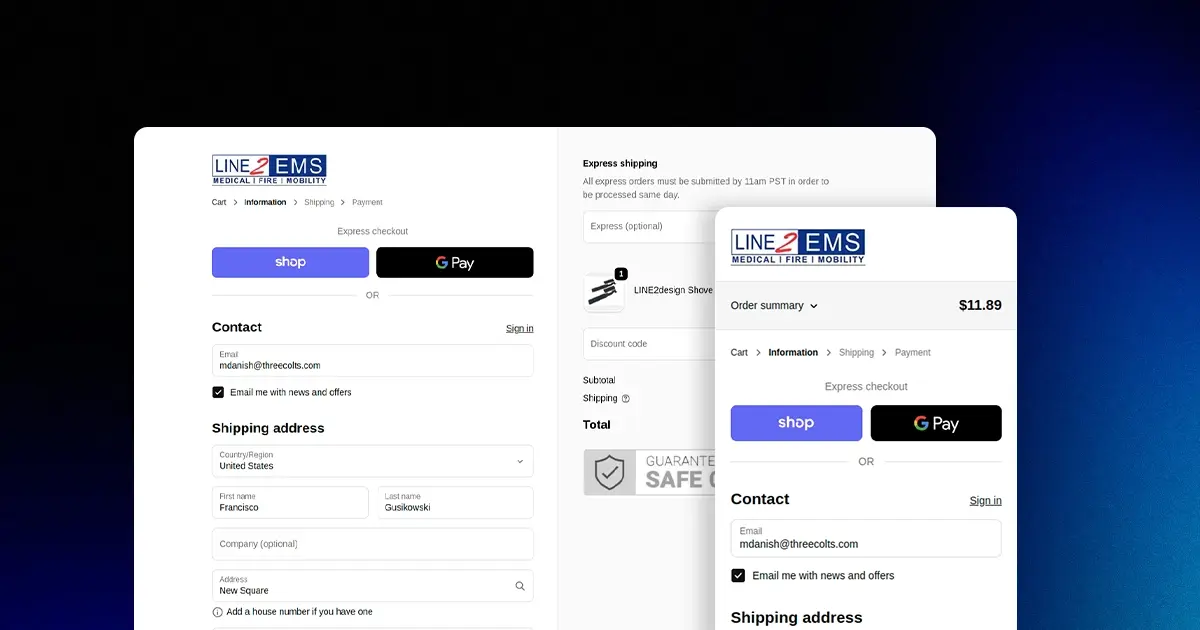Walmart’s ChatGPT Integration Signals a New AI-Driven Retail Era
Reading Time: 3 minutesWalmart has announced a landmark partnership with OpenAI that could reshape the…
On November 17, 2015, Magento 2.0 was released and with that, the debate in the eCommerce turf also started whether to Migrate from Magento 1 to Magento 2 or not and it is still ongoing.
The release of Magento 2 also brought numerous significant features with it that had the potential to change the user experience and take it to a new level also with the release of Magento 2.0, all the innovative juices have started flowing its direction relevantly more than Magento 1.
Let’s go through them one at a time.
To make the whole frame, work faster and prevent it from becoming laggy.
You all must have an idea that structured data is the kind of data that exists in a fixed field in a file or record. Rich snippets are the hike in structured data that can be used for any present HTML so that the search engines understand the data contained on each page.
It means the body of the source code of the software used will be better structured for easy understanding and enhanced performance.
The file structures have been improvised and are easily customizable as well.
Plus many other remarkable features to top it all off.
The bonus part is that many innovators have already developed ready to use frames several add-ons and extensions based on Magento 2.
Do you know that you can successfully migrate to magento in just 2 weeks!!
Before we jump to the segment of what you should know before you migrate from Magento 1 to Magento 2 and how you can do it the correct way let’s count the reasons why you should make the migration.
This most definitely does not mean that your Magento store will stop working, Of course not! Your Magento store will continue to work the same way without the upgrade to Magento 2. However, once the support services are lifted it simply means that Magento will stop releasing security and feature updates for this particular version. Which implies two things:
Running an Ecommerce site in itself is a mammoth task and on top of that if you have to constantly deal with the hassles of updating your security patches, working on its speed and performance it would eventually end up requiring too much of your efforts.
It means that if you haven’t made your shift from M1 to M2 yet any problem surfaces up regarding your frame Magento might not help you out with that.
We will be answering all your queries, stating the benefits of Magento 2 over Magento 1.x, and would suggest actionable solutions in context with Magento migration through this blog one at a time. Prior to that, it’s important to understand how the shutting down of services of Magento 1.x may impact your store.
Having listed the benefits of Magento 2 over Magento 1.x versions it becomes clear why the sudden shift towards Magento 2 is being observed. A large number of people are opting for an upgrade to Magento 2 for their eCommerce store.
The latest offering by Magento has very soon become the most favored platform for online stores. Sooner or later the decision to migrate from Magento 1 to Magento 2 might become a necessity if not for the support seizure then for its performance-related concerns.
In order to consider and move ahead with Magento 2 upgrade, it is best to have a detailed plan chalked out to migrate from Magento 1 to Magento 2. This plan can best be suggested and executed by professionals that provide Magento migration services.
If you have come this far we hope you would have understood the utility of this Magento 2 upgrade but must be thinking if this would be too troublesome a task to perform. Worry not we have that sorted for you. To begin with, migrating your website you will need to start with some preparations for the same.
Once you are done with the below-mentioned steps CedCommerce will take it from there to assist you completely and perform all the Magento migration services for you. Therefore you need not to worry before taking the call to migrate from Magento 1 to Magento 2. Following steps need to be taken care of prior to an upgrade to Magento 2.
Extension migration while your upgrade to Magento 2 could require some effort on your end. You must have deployed multiple extensions on your online store to arm it with numerous features. If you are using multiple 3rd party extensions it could be a possibility that you have come to realize that there are certain extensions that are used more frequently and need some enhancements whereas on the other hand there are extensions that are seldom used.
This extension migration could be your opportunity to pick the ones that you want to have in your new online store as well. This Magento 2 upgrade might be your time to give your store a new look and feel and enhance its features by shortlisting or adding on the already existing extensions.
It would be advisable to remove the extensions offering redundant features. Once you’re done with the shortlisting it would be important to check if the upgraded extensions are available for them. If yes, extension migration would be possible easily. If not, then these extensions would be required to be built from scratch rather than performing an extension migration activity.
Before proceeding with migration you would be required to check for your server compatibility with Magento 2. Check the server requirements for Magento 2 and then proceed to upgradation (if required).
Theme migration is another crucial part of this upgrade to Magento 2. Magento 2 aims at delivering enhanced shopping experiences to customers on the online store. Which again gives an additional point to it and advocates in the favour of an upgrade to Magento 2. Since Magento 2 differs from Magento 1 largely in terms of structure the themes from your old store (Magento 1) cannot be directly lifted and utilized for the new store.
Instead, the theme for your new store after you migrate from Magento 1 to Magento 2 needs to be built from scratch like the extensions which are not upgradable. Hence in order to provide your customers with a responsive and interactive website, you will need to work on the suggested methods for theme migration.
Prior to migration from Magento 1 to Magento 2, you would also be required to decide the functionality to want to migrate from your old site to the new one. There might be sections in your online store that you might want to remove or include just like extensions discussed in the section for Extension Migration above. This is a good time to review the site for any redundant features or extensions that it might be carrying.
A majority of merchants have already migrated from Magento 1 to Magento 2 successfully. You can refer to the case studies of WiredSport and Khasto.
To make it easier for you we have broken the migration process in 4 simple steps.
You must be thinking that it would be a colossal task to make the “Big Shift” but we will break it down for you in 4 easy steps:
Let’s discuss one at a time:
Moving your Magento 1 configuration and data to Magento 2
Install the desired Magento 2 extensions
Magento offers a Code Migration Toolkit that helps you in this process
You have to create a new theme for Magento 2 and make it responsive for the best user experience
Magento 2 Data Migration Tool helps developers to migrate data and configurations using CLI Commands. Through this, you can easily migrate data(configurations, categories, products, orders, cms pages, and others).
With the help of Data Migration Tool, you can migrate data from the database of Magento 1 platform to the database of Magento 2 platform based on rules that will be defined in the XML files.
Now we will explain to you how to start with migration:
To begin with, you need to install the Data Migration tool into a fresh Magento 2 store using Composer.
Make sure you are using the same released version of both Magento 2 and the Data Migration Tool. For example, for Magento version 2.2.0, you must also use the Data Migration Tool version 2.2.0.
Enter the following command to confirm your Magento version.
php <your Magento install dir>/bin/magento --version
To install the Data Migration Tool, you must update composer.json in the Magento root installation directory to provide the location of the Data Migration Tool package.
composer config repositories.magento composer https://repo.magento.com composer require magento/data-migration-tool:<version>
where <version> must match the version of the Magento 2 codebase.
For example, for version 2.2.0, enter:
composer config repositories.magento composer https://repo.magento.com composer require magento/data-migration-tool:2.2.0
When prompted, enter your authentication keys. Your public key is your username; your private key is your password.
<vendor>/magento/data-migration-tool.
After the installation of the data migration tool, the following directory contains mapping and configuration files:
<your Magento 2 install dir>/vendor/magento/data-migration-tool/etc/opensource-to-opensource
Configuration and scripts for migrating from Magento Open Source 1 to Magento Open Source 2
<your Magento 2 install dir>/vendor/magento/data-migration-tool/etc/opensource-to-commerce
Configuration and scripts for migrating from Magento Open Source 1 to Magento Commerce 2
<your Magento 2 install dir>/vendor/magento/data-migration-tool/etc/commerce-to-commerce
Configuration and scripts for migrating from Magento Commerce 1 to Magento Commerce 2
Before you migrate any data, you must create a “config.xml” configuration file from the provided sample.
<your Magento 2 install dir>/vendor/magento/data-migration-tool/etc/<migration edition>/<ce or version>
cp config.xml.dist config.xml
<source> <database host="127.0.0.1" name="magento1" user="root"/> </source> <destination> <database host="127.0.0.1" name="magento2" user="root"/> </destination> <options> <crypt_key /> </options>
The <crypt_key> tag is mandatory to fill. It can be found in a local.xml file which is located in the directory of Magento 1 instance at app/etc/local.xml in the <key> tag.
Optional parameters:
The Settings mode migrates stores, websites, and system configuration like shipping, payment, tax settings, etc. According to our data migration order, we should migrate settings first.
To start migrating settings, run:
bin/magento migrate:settings [-r|--reset] {<path to config.xml>}
Where:
Once the settings migration is over, a successful message will be displayed.
Run the data migration command
To start migrating data, run:
bin/magento migrate:data [-r|--reset] [-a|--auto] {<path to config.xml>}
Where:
Note: The Data Migration Tool saves its current progress as it runs. If errors or user intervention stop it from running, the Tool resumes progress at the last known good state. To force the Data Migration Tool to run from the beginning, use the –reset argument. In that case, we recommend you restore your Magento 2 database dump to prevent duplicating previously migrated data.
After data migration is complete, you will receive a success message.
Source: Magento Dev Docs
Ever since the advent of Magento 2 Ecommerce, there has been a considerable shift in its favour from eCommerce merchants but now with the support for Magento 1.x coming to an end by this year, the switch would be seen at an even rapid rate.
In order to stay updated with the changing trends of the industry, it’s important to track the requirements and be ready to cater to your customers.
In short, it would be advisable to begin with planning the migration by preparing a list of extensions, features and deciding on the theme that you would want in your new site to be, even if you are not opting for migration right away. You would be ready to migrate from Magento 1 to Magento 2 well in time and this would also give you the time to explore the possibilities for your store prior to and post the upgrade to Magento 2. This would at least help you plan ahead so that you are ready for the big shift in the near future.

Reading Time: 3 minutesWalmart has announced a landmark partnership with OpenAI that could reshape the…

Reading Time: 5 minutesAfter years of tension over the ownership and control of TikTok, the…

Reading Time: 3 minutesWalmart’s new collaboration with OpenAI signals more than a tech upgrade —…

Reading Time: 7 minutesI. INTRODUCTION: The Price Precision Imperative In Amazon’s high-velocity marketplace, even a…

Reading Time: 3 minutesAmazon recently announced a significant change for sellers advertising in Washington state:…

Reading Time: 14 minutesBlack Friday–Cyber Monday used to be a weekend. Now it’s a pressure…

Reading Time: 2 minutesKey Updates Shopify is deprecating the “Sell from all locations to all…

Reading Time: 2 minutesWhat’s New Amazon has published a Data Processing Addendum (DPA) for Multi-Channel…

Reading Time: 2 minutesKey Highlights AI-driven traffic to U.S. retail sites will increase by 520%…

Reading Time: 3 minutesDid you know, a new one-tap ordering feature from Amazon is set…

Reading Time: 2 minutesWalmart has overtaken eBay to become the No. 2 U.S. retail eCommerce…

Reading Time: 2 minutesA new step in AI-driven commerce offers merchants direct access to hundreds…

Reading Time: 2 minutesAmazon has officially launched Amazon Haul in Spain, a budget-focused storefront designed…

Reading Time: 2 minutesOpenAI is bringing ecommerce transactions directly into ChatGPT with the debut of…

Reading Time: 2 minutesAmazon has introduced a new FBA multi-unit discount for Amazon Business orders,…

Reading Time: 2 minutesNews Summary At its recent Etsy Up event (September 2025), Etsy unveiled…

Reading Time: 2 minutesNews Summary eBay has rolled out an update that now defaults all…

Reading Time: 2 minuteseBay has announced its acquisition of Tise, a Nordic consumer-to-consumer (C2C) social…

Reading Time: 3 minutesWalmart’s seasonal practices and incentives around holiday shipping have evolved, impacting seller…

Reading Time: 2 minutesAmazon has revised its variation themes policy for 2025. Instead of removing…